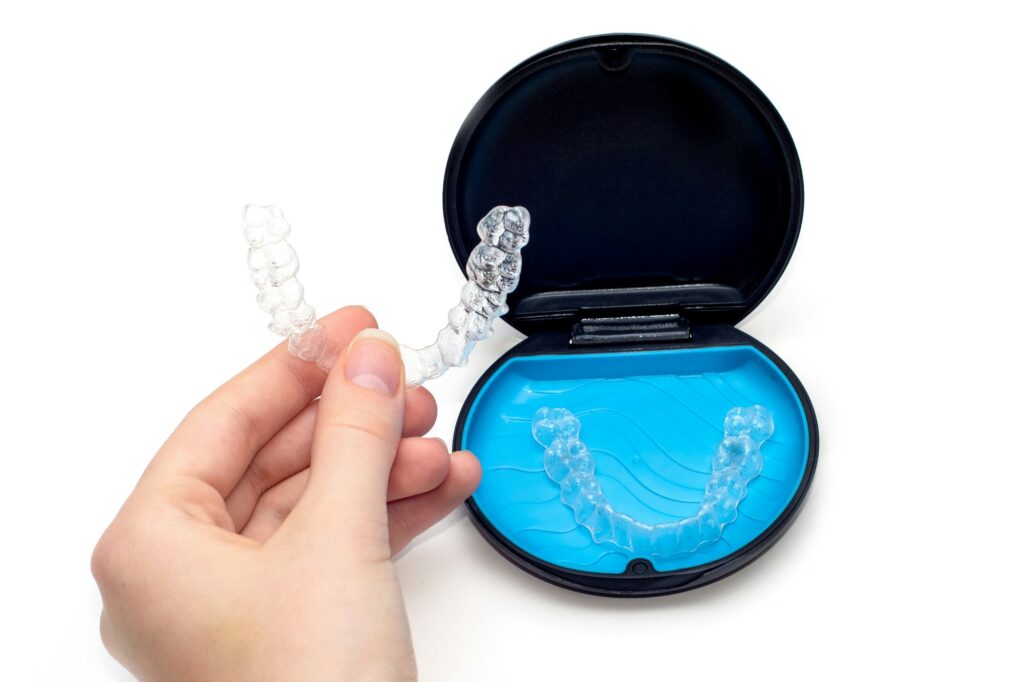You are here because, like all others, you also dream of a straighter smile without the hassle of metal braces. Invisalign might be a perfect solution for you! Whether you are a teenager or an adult, Invisalign aligners offer a discreet and highly effective alternative to align your smile. Continue reading this blog to know what Invisalign is all about and why it might be the solution you are looking for!
What is Invisalign?
Invisalign is literally a combination of the words “invis,” meaning invisible, and “align,” meaning alignment. Thus, it aligns your teeth invisibly.

Invisalign is an orthodontic treatment that uses clear aligners to straighten your teeth. Unlike traditional braces, which use metal wires and brackets to move your teeth to the correct alignment, Invisalign uses a medical-grade plastic mold that fits your teeth. Since the plastic is transparent, it’s not visible and applies pressure invisibly to shift your teeth, gradually leading to a beautiful smile.
How Long Does Invisalign Treatment Take To Straighten Your Teeth?
Invisalign works by applying gentle pressure to correct smile alignment. Since it’s gentle pressure, it is used over time and can not be done suddenly. On average, Invisalign usually takes between 12 and 18 months to straighten teeth. However, this is a generalized figure; some patients can finish their treatment in 6 months, and some take 2 and a half years.
To achieve success with clear aligners, the key is consistent wear. The treatment process usually involves wearing the aligners for at least 20 to 22 hours daily. When you start your treatment, you will be given a new set of aligners, which are meant to be used for around 1 to 2 weeks, and then you will have to get new ones, which will continue to correct the alignment. This way, you will regularly visit your dentist at 10 to 14 days intervals and get a new set of Invisalign aligners until your smile aligns.
Invisalign Treatment And Care
Here’s a guide to the treatment process and care
Consultation:
The first step is to visit us, where our trained dentists will examine your teeth and bite. They will report the issues, devise a treatment plan, discuss your goals, and decide whether Invisalign is the right choice.
Record Taking:
If you choose Invisalign to straighten your teeth, we will proceed to the next step. The next step in the Invisalign process involves your dentist taking bite records. They will take impressions, photographs, and x-rays of your lower and upper jaw to record your teeth and gums.
Custom Treatment Plan:
Using advanced Invisalign technology, your dentist will devise a personalized treatment plan for you. It will depict precisely how Invisalign can correct your teeth into the desired position.

Aligner Production:
Once you and your dentist agree with the treatment plan, treatment with Invisalign will begin, and your custom removable aligners can be created. Invisalign clear aligners are virtually invisible because they are made from clear plastic that is comfortable to wear.
Follow-ups:
Your dental provider will schedule bi-weekly check-ups to ensure your treatment progresses as planned. The good news is that these appointments are less frequent than those for traditional metal braces.
Completion:
Once your treatment goals are achieved and your teeth have been moved into their proper aligners by Invisalign braces, your dentist will recommend retainers. These will help your teeth remain in their correct position for long.
Caring For Your Invisalign Aligners
- Clean your aligners after removing them with soap and cold water. Avoid using toothbrushes and toothpaste to prevent damage.
- Maintain good oral hygiene, brush and floss your teeth twice daily to prevent plaque build-up and tooth decay.
- Remove your aligners while you eat, as it will damage your aligners.
- Keep your aligners stored in a protective casing to prevent damage and losing them.
Why Does Invisalign Treatment Length Vary So Much?
Your dentist will guide you to an expected time for teeth straightening, but they will never pinpoint the exact length of your Invisalign treatment. This is because they require minor adjustments, and some require more extensive work. However, certain factors can help you ascertain how long it will take to average some people only.
- Your Age: The younger you are the shorter your orthodontics treatment will take. It is easier to move teeth in younger softer bone than in older more brittle bone.
- Condition of your teeth: Your teeth can be crowded or spaced for any reason. Minor crookedness can be adjusted within a year. Whereas, it can take around 12 to 18 months to correct moderate cases. In short, the more the crowding or spacing, the longer it’s going to take.
- Extraction: If your teeth are severely crowded, your dentist might remove one tooth on each side of your mouth. Your treatment process usually prolongs to fill in the space created by the extraction.
- Compliance: You need to wear your aligners as directed by your dentist. A little to no compliance can sometimes extend the treatment time to double.
How Long Does Invisalign Take To Close A Gap?
As said before, treatment time varies significantly between patients. This depends on factors like age, compliance, and complexity of each case. However, generally, it can be said that.
- Small spaces take up to 6 months.
- Moderate spaces take up to a year.
- Large spaces can take up to 24 months to close.
How Long Does Invisalign Take For Crowded Teeth?
Treatment times for crowding depend on factors such as age, tooth condition, willingness to follow your dentist’s advice, and the complexity of the case.
1. Mild crowding: Up to 9 months
2. Moderate crowding: Up to 12 months
3. Severe crowding: Up to 30 months
Additionally, the treatment times for other dental issues can take
1. Mild Overbite: Up to 9 months
2. Moderate Overbite: Up to 15 months
3. Severe Overbite, Underbite, and Open Bite: Up to 36 months.
Does Invisalign Take Longer To Straighten Teeth For Adults?
Yes, there is a chance Invisalign takes a little longer to straighten teeth for adults due to denser bone, more chances of gum recession, gum inflammation, periodontitis, and existing dental work.

However, the difference is not that significant and varies significantly with the complexity of the malalignment. A more straightforward case of an adult will be completed sooner than a complex case of a teenager.
Recommended Daily Time For Wearing Invisalign
The orthodontist recommends wearing Invisalign aligners for 20 to 22 hours daily. You should wear your aligners all day and night to ensure you get the maximum benefits of Invisalign aligners. You can only take them off when eating, drinking, brushing, or on a special occasion.
What Orthodontic Issues Can And Can’t Invisalign Fix?
Although several cases can be treated with Invisalign, treating every orthodontic issue with aligners is still impossible. Invisalign is not fit for you if you have
- Complex bite issues like severe overbite, underbite, and crossbites.
- Jaw bone alignment issues
- Extrusion of teeth
- Correction of severely rotated teeth
Invisalign is suitable for cases with
- Mild to moderate spaces and crowding
- Diastema (space between upper front teeth)
- Intrusion of teeth
- Previous orthodontic treatment relapse cases
- Minor underbite and overbite
- Aesthetically conscious patient
Start Your Journey To A Better Smile!
Say goodbye to the conventionality and self-consciousness of metal braces and hello to a bright, confident, and hassle-free smile with Invisalign aligners. Please let me know what you’re waiting for. Contact us to link with our top dentist and schedule your consultation today!
More Dental Related Articles:
Transform Your Smile: Dental Crowns Before and After
